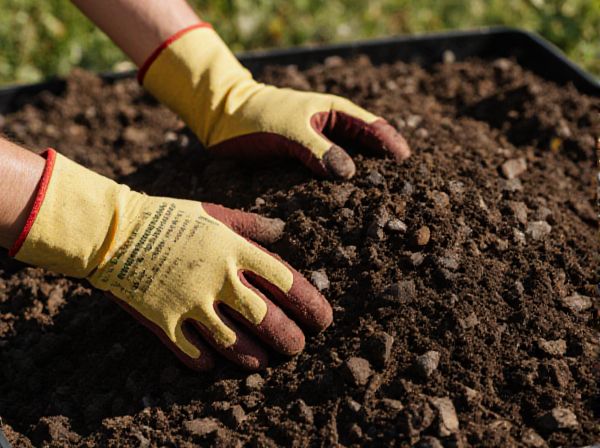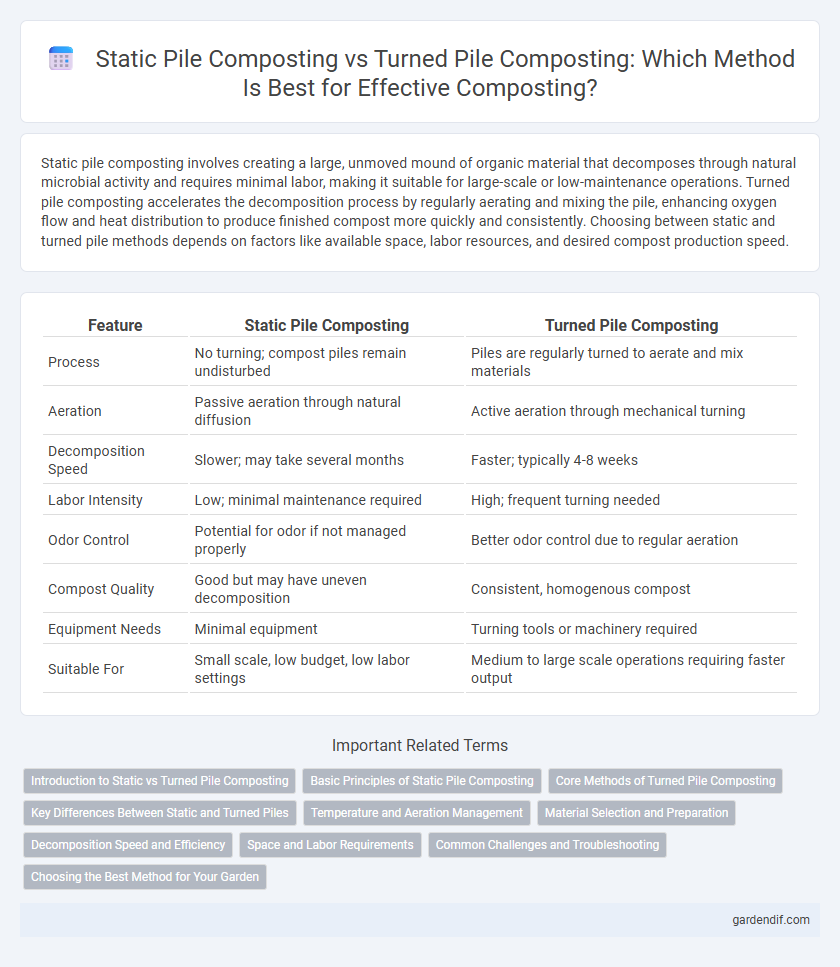
Static pile composting vs Turned pile composting Illustration
Static pile composting involves creating a large, unmoved mound of organic material that decomposes through natural microbial activity and requires minimal labor, making it suitable for large-scale or low-maintenance operations. Turned pile composting accelerates the decomposition process by regularly aerating and mixing the pile, enhancing oxygen flow and heat distribution to produce finished compost more quickly and consistently. Choosing between static and turned pile methods depends on factors like available space, labor resources, and desired compost production speed.
Table of Comparison
| Feature | Static Pile Composting | Turned Pile Composting |
|---|---|---|
| Process | No turning; compost piles remain undisturbed | Piles are regularly turned to aerate and mix materials |
| Aeration | Passive aeration through natural diffusion | Active aeration through mechanical turning |
| Decomposition Speed | Slower; may take several months | Faster; typically 4-8 weeks |
| Labor Intensity | Low; minimal maintenance required | High; frequent turning needed |
| Odor Control | Potential for odor if not managed properly | Better odor control due to regular aeration |
| Compost Quality | Good but may have uneven decomposition | Consistent, homogenous compost |
| Equipment Needs | Minimal equipment | Turning tools or machinery required |
| Suitable For | Small scale, low budget, low labor settings | Medium to large scale operations requiring faster output |
Introduction to Static vs Turned Pile Composting
Static pile composting involves creating a large, unmoved pile of organic waste that decomposes slowly through natural microbial activity, requiring minimal labor and aeration. Turned pile composting accelerates decomposition by regularly aerating the pile through mechanical or manual turning, enhancing oxygen flow and microbial metabolism. Both methods transform organic materials into nutrient-rich compost, with turned pile composting offering faster processing times and better temperature control.
Basic Principles of Static Pile Composting
Static pile composting involves accumulating organic waste into undisturbed large piles, relying on natural microbial activity for decomposition without frequent turning or aeration. The key principle is maintaining optimal moisture content and temperature within the pile by controlling pile size, ventilation, and moisture to facilitate aerobic microbial processes. This method suits large-scale operations where minimal labor is preferred, promoting gradual breakdown of organic material while minimizing energy inputs.
Core Methods of Turned Pile Composting
Turned pile composting involves regularly aerating organic waste by mechanically or manually turning the compost pile, which accelerates decomposition and helps maintain optimal oxygen levels. This method enhances microbial activity through frequent mixing, resulting in faster breakdown of materials and more uniform temperature distribution within the pile. Core techniques include scheduled turning intervals, moisture monitoring, and temperature control to ensure efficient and high-quality compost production.
Key Differences Between Static and Turned Piles
Static pile composting involves minimal aeration as organic waste decomposes in a stationary heap, relying on passive airflow and moisture management. Turned pile composting requires regular mechanical turning to introduce oxygen, accelerate decomposition, and maintain an even temperature throughout the pile. Key differences include oxygen availability, decomposition speed, temperature control, and labor intensity, with turned piles offering faster composting but higher labor demands compared to static piles.
Temperature and Aeration Management
Static pile composting relies on passive aeration and natural microbial activity, often resulting in lower and less consistent temperature profiles compared to turned piles. Turned pile composting involves regular mechanical agitation to introduce oxygen, promoting higher temperatures and faster organic matter breakdown. Effective temperature and aeration management in turned piles enhances pathogen kill rates and accelerates compost stabilization.
Material Selection and Preparation
Static pile composting requires careful selection of materials with balanced carbon-to-nitrogen ratios and adequate moisture content, as the pile remains undisturbed and relies on passive aeration. Turned pile composting allows for a broader range of materials, including coarser organic matter, since regular turning promotes oxygen flow and accelerates decomposition. Proper shredding and mixing of feedstock enhance microbial activity in both methods but are especially critical in static piles to prevent anaerobic conditions.
Decomposition Speed and Efficiency
Static pile composting typically involves slower decomposition due to limited oxygen flow, which reduces microbial activity and extends the composting timeline. Turned pile composting enhances oxygen penetration by regularly mixing the materials, significantly accelerating microbial breakdown and resulting in faster and more efficient compost production. Efficiency in nutrient cycling and pathogen reduction is generally higher in turned piles because of consistent aeration and moisture distribution.
Space and Labor Requirements
Static pile composting requires less labor since the organic material remains undisturbed during decomposition, making it ideal for limited workforce availability. This method demands more space to accommodate larger piles that facilitate proper aeration without turning. Turned pile composting, conversely, needs frequent manual or mechanical aeration to speed up decomposition, increasing labor intensity but allowing for more compact pile sizes and efficient space use.
Common Challenges and Troubleshooting
Static pile composting often faces challenges like inadequate aeration, leading to slow decomposition and odor issues due to anaerobic conditions. Turned pile composting requires regular mechanical turning to maintain oxygen levels, but improper turning frequency can disrupt microbial activity or cause temperature fluctuations. Both methods demand careful moisture control and monitoring to prevent nutrient loss and ensure efficient organic matter breakdown.
Choosing the Best Method for Your Garden
Static pile composting requires less labor and is ideal for gardeners seeking low-maintenance organic waste management, promoting slow decomposition through natural aeration. Turned pile composting accelerates breakdown by regularly aerating the materials with tools or machinery, producing nutrient-rich compost faster for gardens needing quick soil enrichment. Selecting the best method depends on garden size, time availability, and desired compost production speed.
Static pile composting vs Turned pile composting Infographic

 gardendif.com
gardendif.com